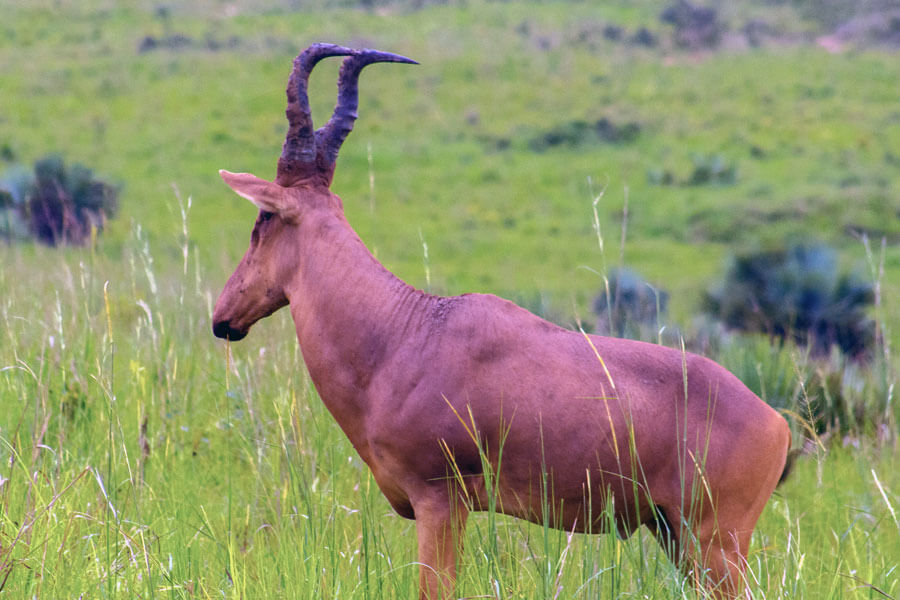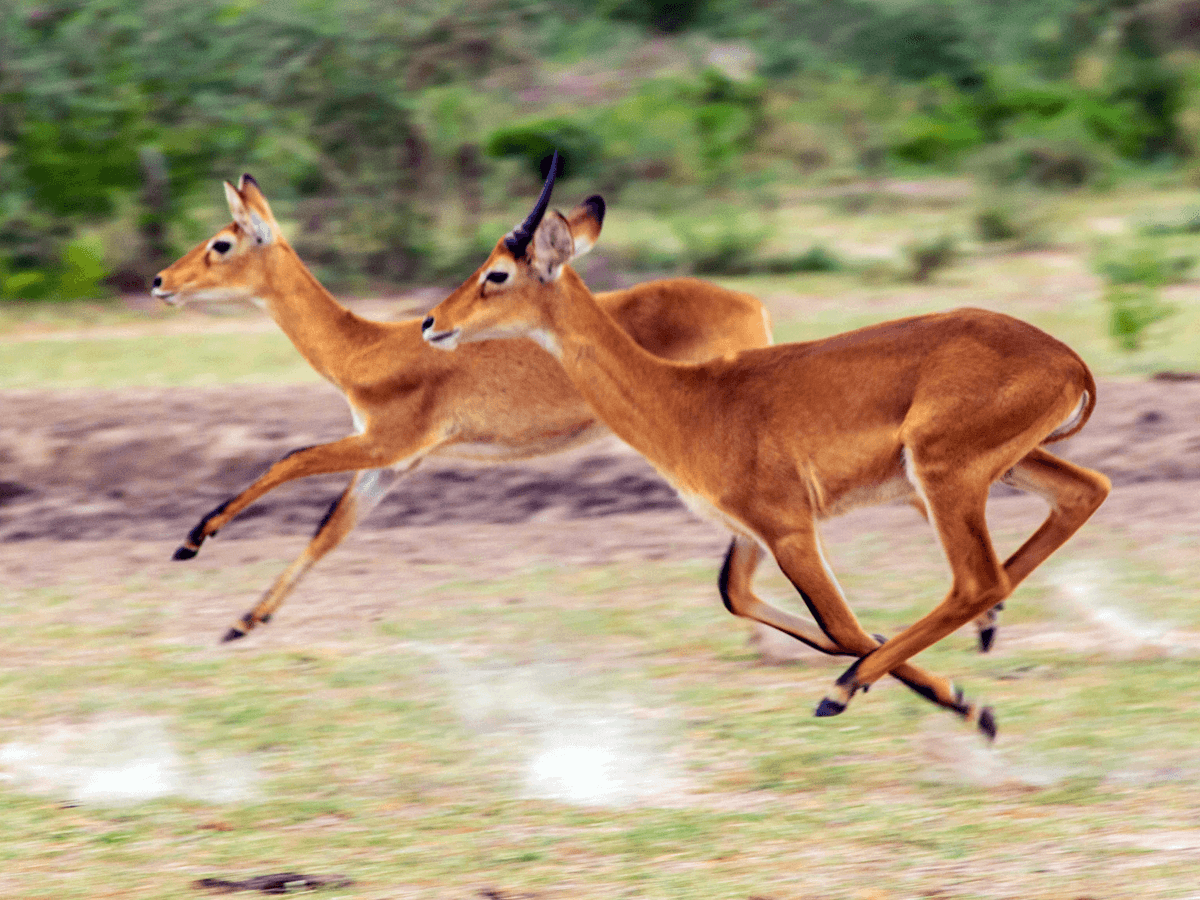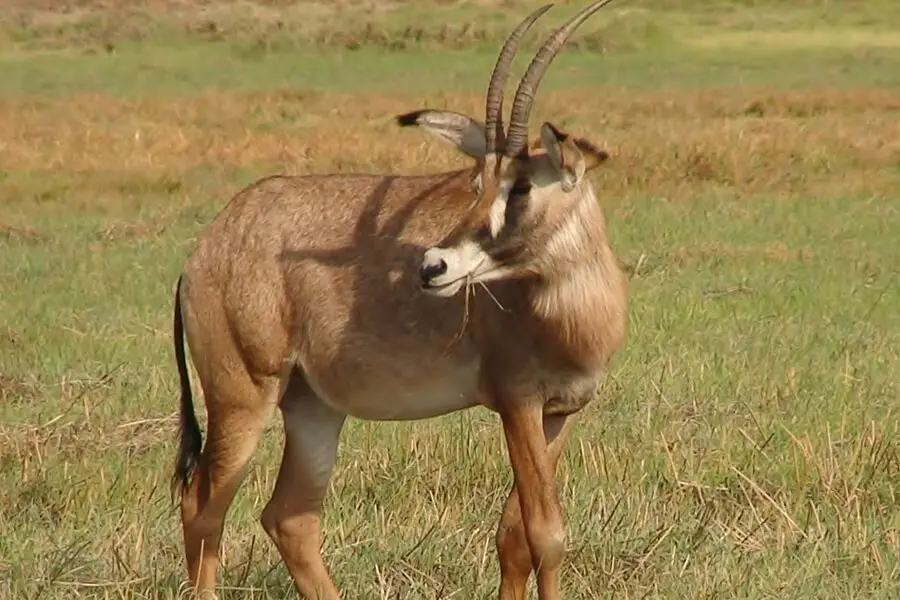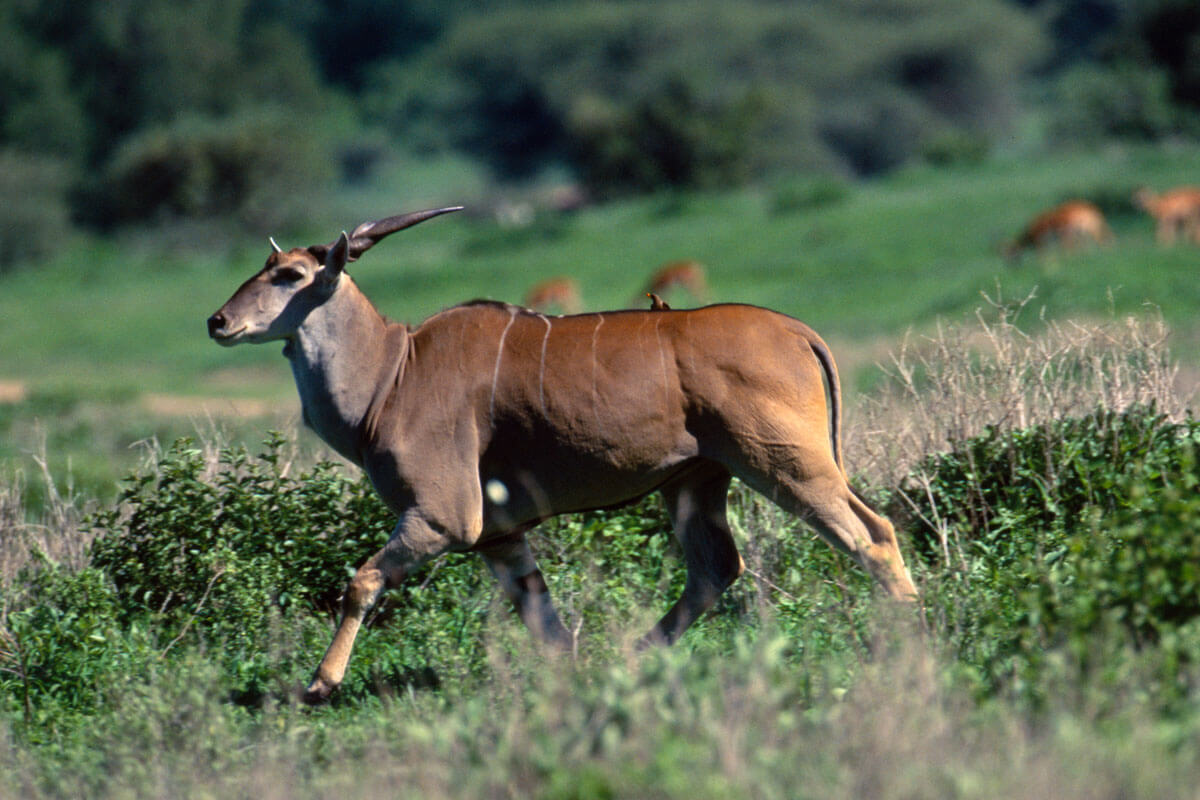Africa's wild places are known for their diversity of wildlife in the open savannahs and thick forests. While animals like lions, elephants, giraffes and gorillas are favourites to see on safari, their true diversity rests on the abundance of various antelopes. They are the all-important part of the puzzle that keeps these wonderful ecosystems in balance.
Some antelope species such as wildebeest and oryx are quite prominent and well-known as part of the African wilderness, but others such as the Addax and Grey Rhebok are unknown.

In this article, we'll shine a light on all the antelope species in Africa and give you some basic information about their weight and habitat. We'll also take a look at what animals are truly antelopes and their role in the ecosystems. The goal is to inspire you to see magic at every moment of your African safari - and not only when you see the more popular animals like zebras, lions and leopards.
What is an Antelope
The term antelope is often used as a "catch-all" term for many animal species in the Bovidae family that live in Africa and Asia. These animals are herbivores, hooved and have horns and this is why it can also include animals like sheep, goats and cattle.
Scientifically, Antelope is not a perfect category but it works well as a common term especially when thinking about many of the animals that fall under this huge family gathering.
Role of Antelopes in the Ecosystem
Antelopes play a vital role in maintaining the health and balance of their local ecosystems.
As herbivores, they are essential in controlling the overgrowth of vegetation as well as seed dispersal in the forest. Their dung is also a healthy fertilizer for the wild, and a source of food for smaller insects and parasites.

Another important role of antelopes is to provide prey for predators like lions, leopards, cheetahs and wild dogs. Without many of the antelopes in Africa, you can be certain that there wouldn't be any lions, leopards or other big predators. This is because antelopes form the bulk of small and medium prey that most of these predators hunt for food.
As is true in nature, there is balance and antelopes are central to the balance in the African wilderness. Whether it is ensuring the health of grasslands and forests or the carnivores that eventually prey on them, without antelopes, the African wildlife safari seems impossible to imagine.
African Antelopes
Now that we know what antelopes are and how important they are, it makes sense that we shine some light on all the antelopes in Africa.
We have included the average weight and ecosystem of each. This is so that you can get an idea of their wide diversity in size, and the kinds of environments they live in.
Here is a list of 49 antelope species in Africa. Some subspecies have been left out to avoid going too far and making this hard to understand.
| # | Common Name | Scientific Name | Weight (kg) | Ecosystem |
|---|---|---|---|---|
| 1 | Addax | Addax nasomaculatus | 60 - 120 kg | Sahara Desert, Arid Plains |
| 2 | Bates' Pygmy Antelope | Neotragus batesi | 3 - 6 kg | Forests, Savannas |
| 3 | Beira | Dorcatragus megalotis | 10 - 15 kg | Rocky Terrain, Mountains |
| 4 | Black Wildebeest | Connochaetes gnou | 100-180 kg | Grasslands, Plains |
| 5 | Blue Duiker | Philantomba monticola | 4 - 6 kg | Forests, Dense Vegetation |
| 6 | Blue Wildebeest | Connochaetes taurinus | 120 - 270 kg | Grasslands, Plains |
| 7 | Bohor Reedbuck | Redunca redunca | 50 - 90 kg | Wetlands, Grasslands |
| 8 | Bongo | Tragelaphus eurycerus | 150 - 320 kg | Tropical Rainforests |
| 9 | Bushbuck | Tragelaphus scriptus | 40 - 80 kg | Forests, Bushlands |
| 10 | Common Duiker | Sylvicapra grimmia | 12 - 25 kg | Woodlands, Savannas |
| 11 | Common Eland | Taurotragus oryx | 400 - 1,000 kg | Grasslands, Woodlands |
| 12 | Common Impala | Aepyceros melampus | 40 - 75 kg | Savannas, Woodlands |
| 13 | Dama Gazelle | Nanger dama | 35 - 60 kg | Sahel, Semi-arid Grasslands |
| 14 | Fringe-eared Oryx | Oryx beisa callotis | 100 - 210 kg | Desert, Arid Plains |
| 15 | Gemsbok | Oryx gazella | 100 - 210 kg | Desert, Arid Plains |
| 16 | Gerenuk | Litocranius walleri | 28 - 52 kg | Dry Scrub, Woodlands |
| 17 | Giant Eland | Taurotragus derbianus | 800 - 1,000 kg | Savannas, Woodlands |
| 18 | Grant's Gazelle | Nanger granti | 35 - 80 kg | Grasslands, Plains |
| 19 | Greater Kudu | Tragelaphus strepsiceros | 190 - 270 kg | Woodlands, Scrub |
| 20 | Grey Rhebok | Pelea capreolus | 20 - 30 kg | Mountains, Rocky Terrain |
| 21 | Guenther's Dik-dik | Madoqua guentheri | 3 - 6 kg | Bushlands, Scrub |
| 22 | Hartebeest | Alcelaphus buselaphus | 120 - 200 kg | Grasslands, Plains |
| 23 | Hirola (Hunter's hartebeest) | Beatragus hunteri | 80 - 120 kg | Grasslands, Woodlands |
| 24 | Klipspringer | Oreotragus oreotragus | 10 - 18 kg | Rocky Terrain, Mountains |
| 25 | Korrigum | Damaliscus korrigum | 80 - 150 kg | Grasslands, Floodplains |
| 26 | Lesser Kudu | Tragelaphus imberbis | 100 - 140 kg | Woodlands, Scrub |
| 27 | Lowland Nyala | Tragelaphus angasii | 140 - 280 kg | Woodlands, Forests |
| 28 | Mountain Nyala | Tragelaphus buxtoni | 140 - 280 kg | Afro-alpine Zones, Woodlands |
| 29 | Mountain Reedbuck | Redunca fulvorufula | 25 - 35 kg | Mountains, Grasslands |
| 30 | Nile Lechwe | Kobus megaceros | 90 - 130 kg | Swamps, Floodplains |
| 31 | Oribi | Ourebia ourebi | 15 - 22 kg | Grasslands, Marshes |
| 32 | Patterson's Eland | Taurotragus oryx pattersonianus | 500 - 900 kg | Savannas, Woodlands |
| 33 | Red-fronted Gazelle | Eudorcas rufifrons | 15 - 30 kg | Deserts, Semi-arid Grasslands |
| 34 | Roan Antelope | Hippotragus equinus | 220 - 300 kg | Woodlands, Grasslands |
| 35 | Royal Antelope | Neotragus pygmaeus | 2 - 3 kg | Forests, Dense Vegetation |
| 36 | Sable Antelope | Hippotragus niger | 200 - 270 kg | Woodlands, Grasslands |
| 37 | Sharpe's Grysbok | Raphicerus sharpei | 8 - 13 kg | Bushlands, Scrub |
| 38 | Sitatunga | Tragelaphus spekii | 80 - 120 kg | Swamps, Marshes |
| 39 | Southern Lechwe (Lechwe) | Kobus leche | 80 - 120 kg | Swamps, Floodplains |
| 40 | Southern Reedbuck | Redunca arundinum | 35 - 70 kg | Wetlands, Grasslands |
| 41 | Springbok | Antidorcas marsupialis | 30 - 50 kg | Grasslands, Deserts |
| 42 | Suni | Neotragus moschatus | 3 - 5 kg | Forests, Dense Vegetation |
| 43 | Thomson's Gazelle | Eudorcas thomsonii | 15 - 25 kg | Grasslands, Plains |
| 44 | Tiang | Damaliscus lunatus tiang | 100 - 200 kg | Grasslands, Floodplains |
| 45 | Topi | Damaliscus lunatus jimela | 120 - 180 kg | Grasslands, Plains |
| 46 | Tsessebe | Damaliscus lunatus | 120 - 140 kg | Grasslands, Floodplains |
| 47 | Uganda Kob | Kobus kob thomasi | 90 - 110 kg | Savannahs, Woodlands |
| 48 | Gey Rhebok (Vaal Rhebok) | Pelea capreolus | 25 - 30 kg | Mountains, Rocky Terrain |
| 49 | Waterbuck | Kobus ellipsiprymnus | 200 - 300 kg | Grasslands, Wetlands |
Antelopes are rarely the focus of most people's wildlife safaris, but when you are with an experienced guide, he/she will tell you about the ones you meet. Maybe they are forgetful and often stop running and get caught by the lion, or they are big and yet agile jumpers - it all depends on where you are and which antelope you will see.
With the knowledge about how important these antelopes are in shaping the African wilderness, you will enjoy seeing them on safari in a way most people wouldn't understand. They are the perfect image of the ever-giving underdog.

Frequently Asked Questions
Here are a few common questions people ask about Antelopes.
Is An Antelope A deer?
Despite some seeming similarities, antelopes are not related to deer. Antelopes are more closely related to other bovides such as cows, goats, and bison while deers are more related to elk and moose.
Another major difference between deer and antelopes is the horns and antlers. The horns of antelopes are permanent and grow continuously but the antlers of male deers are made of bone and often shed annually.
What is the most common antelope in Africa?
The most common antelope species in Africa is the impala. They are widespread and present in most countries south of the Sahara desert.
Impalas are very social animals that live in large herds comprising females and their young ones, as the males form a separate bachelor herd. They are quick and capable of 9-metre (30-foot) leaps in a single bound - which helps them escape from the predators.
What is the fastest Antelope in Africa?
The fastest of all African antelopes is the Common Tsessebe which can reach speeds of up to 90 kilometers per hour (55 miles per hour). The Tsessebe is lean with long legs and a streamlined body built for high-speed running, necessary adaptations if it is to outrun predators such as lions and cheetahs.
For Context, only the cheetah is capable of a speed faster than the Tsessebe. And the cheetah can not maintain extreme speeds for longer than a few minutes.
What is the largest antelope in Africa?

The largest antelope in Africa is the Giant Eland. Adult males can reach a height of 6 feet at the shoulder and weigh up to 1200 kg (2650 lb).
Giant Elands are massive and will generally be bigger than most cows (cattle). They are social and live in herds of up to 25 individuals.
Despite their large size and weight, Elands are very agile and capable of jumping over a fence from a starting leap.
What is the smallest antelope in Africa
The smallest antelope in Africa [and the world] is the royal antelope that lives in the lowland rainforests of West Africa. It stands at about 25 centimetres (10 inches) at the shoulder and weighs 2.5 to 30 kilograms (5.5 to 7 pounds).
The Royal antelope is as big [or small] as a hare.
Do humans hunt & eat antelopes
Yes, humans hunt and eat antelopes.
In most places, antelopes live in protected areas such as national parks and game reserves where hunting is prohibited. This has greatly reduced the hunting and eating of Antelopes in Africa.
In some protected areas, abundant species of antelope are available for hunting. This can be trophy hunting for tourists, or subsistence hunting for local communities.
Many countries have strict regulations against all forms of wildlife hunting, and the hefty fines and prison times have reduced the hunting of antelopes and other wild animals. Instead of hunting animals to manage their populations, they are instead being relocated to other wild areas that have smaller numbers.
What do Antelopes eat?
Antelopes are herbivores and thus eat plant matter such as leaves, grass, shrubs, fruits and seeds. Bigger antelopes tend to be grazers that feed primarily on grass but the smaller ones tend to be browsers that focus more on leaves, shrubs and fruits.
What each kind of antelope eats depends on the season and available resources in its habitat. It is because of factors like seasonal changes that we have events like the Great migrations where millions of wildebeest move hundreds of kilometres for better pastures.
While all antelopes are herbivores, there are a few exceptions - especially duikers that can supplement their diet with insects of small birds. This is quite strange, but such is nature and how different animals adapt to survive.
Closing Thoughts
Hopefully, you now see that antelopes are much more than food for lions, or simply the other animals you see on a wildlife safari. They might not be as feared as the lion or as grand and imposing as the elephant, but their place in the African wilderness is undeniable.
And now you have much more to look forward to and appreciate when you go on a classic wildlife safari.
